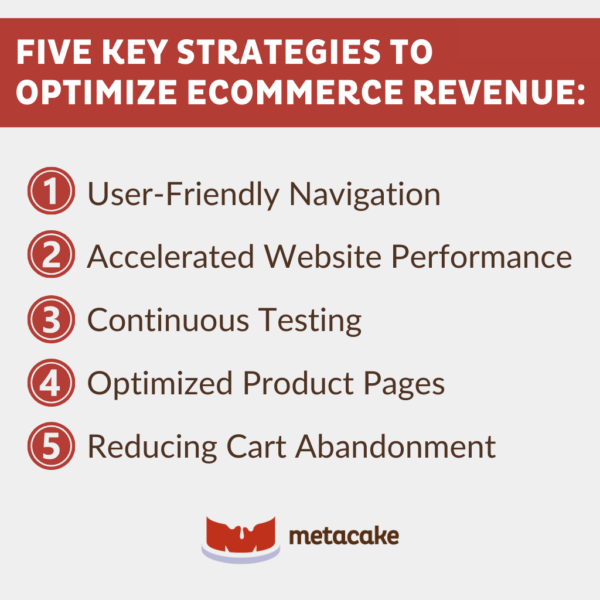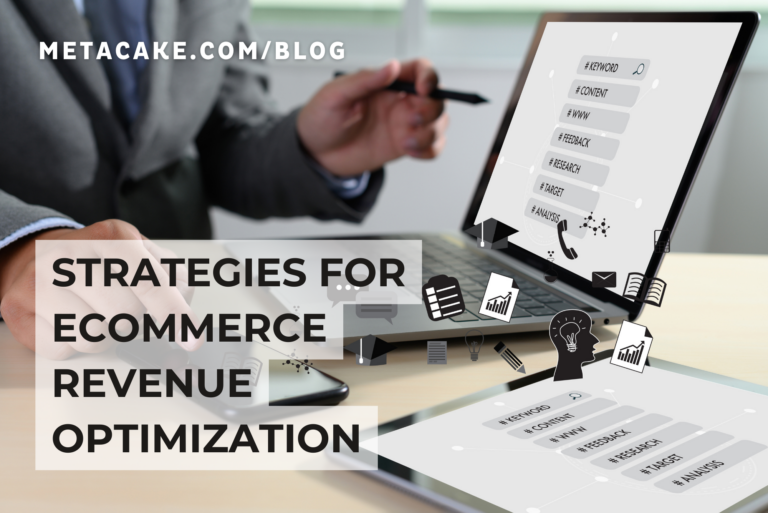So, you want to optimize your ecommerce revenue? Who doesn’t?
Do you already have more quality traffic than you know what to do with? If so, what you need to do now is focus on making more money from the visitors you already have.
If you have a high level of traffic, you should focus on your conversion rate (increasing the percentage of visitors who make a purchase). It’s often less expensive than buying more traffic.
Did we mention that an increased conversion rate will make every dollar you spend on driving traffic to your site more effective?
But where do you start? In this article, we’ll guide you through some common practices for optimizing your ecommerce revenue.

5 Key Strategies to Optimize Ecommerce Revenue
User-Friendly Navigation
When optimizing your website to increase conversions, it’s best to focus first on the areas where customers make decisions (that is, along your conversion funnel).
Often, you can improve conversions by reducing the number of clicks (or pages) along the conversion path and reducing the number of choices that a customer has (in terms of options, colors, etc.).
This may sound counterintuitive because, after all, people love options! Actually, they don’t. We might think we like options, but in reality, fewer choices (no more than three) trigger more sales.
Now, we’re not recommending that you limit your product line to three products. But we are recommending that you think about the product options that you offer, as well as look at how you organize your product line in order to make it as quick and easy for customers to navigate to what they’re looking for.
Get creative, and if you have a complex product line, make sure that you have advanced filtering as well as a stellar search in place.
Accelerated Website Performance
Website speed is not only a Google ranking factor; it’s also a conversion factor. A slow-running website can make your potential customers run for the hills.
According to Medium, fast website performance is no longer optional; it’s a competitive necessity. They cite the following information regarding speed and bottom-line business metrics:
- Conversion rates are 3% higher on faster-loading sites.
- Almost 70% of consumers say page speed affects their likelihood of purchasing.
- 50% of site visitors will abandon the site if it takes more than 6 seconds to load.
Continuous Testing
Contrary to popular belief or what you may have read about A/B testing, changing the color of your “Add to Cart” button or adjusting the font size of your prices most likely isn’t going to move the needle in any meaningful way.
But here are a few areas to test that might:
- Explanation: Determine the appropriate amount of information to include in your conversion funnel.
- Images: Usually, lifestyle photographs perform better than product images alone, or a combination of both, but the correct mix depends on your individual product and business.
- Sequence: Determine the optimal order of material on core pages based on visitor preferences.
- Approach: Educating people about your business and products may be more effective than hard selling, depending on your target population.
- Video vs. Text/Imagery: Choose the medium that aligns with your content goals and audience preferences. Visual storytelling, whether through video, imagery, or a combination, can enhance engagement and convey your message effectively.
- Trust Elements: Test various warranties or guarantees, reviews, and additional social proof elements.
- Homepage Hero Images: Test different offers, photography, and product presentations.
- Upsells vs. Streamlining: There’s a delicate balance between including cart upsells and streamlining the checkout process. Both strategies have their merits and can significantly impact revenue and customer experience.
- Shipping: Including shipping messaging throughout the entire store — as opposed to solely in the cart flow — and conducting a free shipping threshold test could have distinct effects on consumer behavior and sales. In practice, a combination of these strategies might work best, but it’s essential to continuously test.
The right tests for you will depend on your analytics and page performance along the conversion funnel. Take a look at your analytics to identify areas of drop-off in the conversion funnel. We recommend starting closest to the checkout with tests and moving back toward the homepage.
Optimized Product Pages
A high-converting product page needs to be simple. It should include all the information that a customer needs in order to make a decision on your product, but not more.
If you have an overwhelming amount of information on your product pages, your customers will be confused. And simply put, confused customers don’t buy.
This is a pitfall many fall into when they use templates to create their ecommerce sites. Many templates include a spec section with several bullet points, making you feel that you need to fill this in for your products as well, but perhaps (and most likely) your product doesn’t need this level of detail to sell.
These pages are one of the primary ways people navigate and discover products on your ecommerce website.
They also function as landing pages. Shoppers looking for a certain type or category of product may reach your website by searching for a general word.
This is a great thing to test through a CRO platform like VWO, Optimizely, or Google Optimize.
Reducing Cart Abandonment
Preventing cart abandonment, as well as having cart recovery strategies, will help increase your conversion rate.
To prevent cart abandonment, make sure your checkout is clean and simple. Reduce distractions and streamline the checkout process.
Poorly designed checkouts are a conversion killer. If there are too many steps, you’re sure to lose people. But the biggest offender causing cart abandonment is surprise, especially when it comes to shipping costs.
Don’t hide shipping costs until the third step of checkout and then hit your customers with an outrageous charge. Instead, reveal shipping charges up front, either across your entire store or at the first step of checkout.
Be sure to have a cart recovery strategy. Customers who abandon their carts are low-hanging fruit. They went all the way through the process of finding products and adding them to their cart. This shows a super high level of customer interest, so focus on getting these customers across the line.
Final Thoughts
Ecommerce revenue optimization is something that you should always be doing. The best stores never stop testing in order to improve their revenue, and neither should you.
Having said that, we understand how overwhelming it can be. Don’t let this stop you from optimizing your ecommerce revenue.
Our experts are just a click away, so give us a shout!
